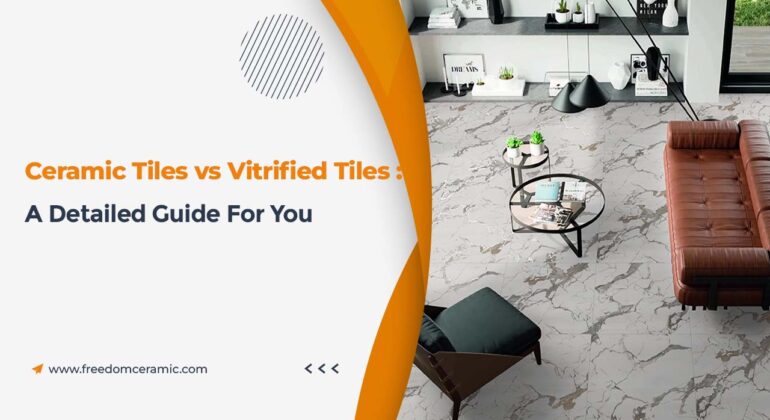Are you finding suitable flooring options for your new home or office? We bet you will consider durability and appearance as important factors when deciding. Honestly, you may find it difficult to choose the best option unless you know the basics of the trade yourself.
Whether you are redoing your home interiors or putting together your dream house, you need to get involved in the nitty-gritty of the tile selection process. All tiles can accentuate your place with natural radiance. However, various factors and elements, including your personal choices and preferences, play a major role.
To avoid frenzy during the selection process, understand the two major types of tiles available in the market. They are Ceramic Tiles and Vitrified Tiles. The purpose of the blog is to help you make the right choices between the two, and for that, you must know what they are and how they differ.
What are Ceramic Tiles?
Ceramic tiles are made from natural clay and various other materials. They have a porous texture created by firing at high temperatures in the kiln. Ceramic tiles are known for their visually appealing designs and stunning colors and patterns. They have a tough glazed protective layer that makes them resistant to water, scratches, and stains. Mostly ceramic tiles are used for wet areas like bathrooms and kitchens.
Advantages of Ceramic Tiles
- They are easy to upkeep and are resistant to stains, dirt, and colors. You can clean them with a damp mop or sponge.
- Unlike other flooring options like natural stone or hardwood, ceramic tiles are inexpensive and durable
- They are tough due to glazing and can resist heavy traffic. They can last longer for more than 15 years.
- Ceramic tiles are resistant to fire and do not produce smoke or toxic fumes
- They are easy to install if done with the right tools and instructions from professionals.
What are Vitrified Tiles?
When additional components like quartz and silica are added to the mixture of ceramic tiles, they become vitrified tiles. The major difference here is that vitrified tiles undergo a vitrification process that makes them durable and less porous than regular ceramic tiles. The composition of silica, quartz, and feldspar makes them look like glass.
Advantages of Vitrified Tiles
- They are glossy and have a smooth finish, making them rich and luxurious.
- They can make rooms brighter and larger due to the reflection of light
- Vitrified tiles are resistant to scratches and scrapes due to their non-porous surface.
- They are impervious to water and stain penetration because of low porosity.
- They need less maintenance and can be easily cleaned
- Due to their low porosity, they absorb very little water and are moisture-resistant
Major Differences Between Ceramic Tiles and Vitrified Tiles
Composition
Ceramic tiles are composed of minerals, clay, and water. Post-mixture, they are fired in a kiln at high temperatures. Due to the firing process, the clay is hardened, converting it into ceramic tiles.
Vitrified tiles are manufactured by mixing silica with other raw materials and undergo the vitrification. In this process, materials are heated at high temperatures till they look like glass. Hence, the floor tiles become non-porous, highly durable, and water resistant. Vitrified tiles are popular because of their durability, low maintenance, and ability to withstand high-traffic zones.
Porosity
Both ceramic tiles and vitrified tiles differ in terms of porosity. As ceramic tiles are made out of clay and natural materials, they are porous and may absorb liquids. The floor may be susceptible to getting stains and water may damage its overall look.
On the contrary, vitrified tiles are prepared by fusing silica and other minerals through the vitrification process. This makes them completely non-porous. Hence, they are known for their low porosity, which makes them highly resistant to water, scratches, and stains. This property also makes them ideal for areas having high moisture where spills are common.
Finish
Both differ in the finishing aspect. Ceramic tiles have a glazed finish that makes them appear shiny and reflective. The glaze protects them from water and stains. It makes them ideal for all types of spaces, especially kitchens and bathrooms.
On the other hand, vitrified tiles have a polished or matte finish, making them more subtle and moisture-resistant. Vitrified tiles are known for being less porous and resistant to scratches and stains. So they are ideal for high-traffic areas like hallways and living rooms.
Durability
The durability of ceramic tiles is phenomenal. However, they may not be as tough as vitrified tiles. Ceramic tiles may develop cracks and chips due to heavy falls.
Vitrified tiles are powerfully robust and can withstand heavy traffic. Due to their solid strength, they are the best tile option currently. Moreover, they are resistant to stains, scratches, and chips.
Cost
The cost of vitrified tiles is relatively more than ceramic tiles. The differences in cost are derived from their manufacturing process and material compositions. Ceramic tiles use raw materials like clay, feldspar, sand, and other minerals. They are prepared by dry pressing, extrusion, and slip casting. Later they are dried, fired, glazed, fired a second time, and then packed after a quality check.
Vitrified tiles are made with clay, feldspar, silica, and other minerals with a slightly different composition than ceramic tiles. The materials are mixed, ground, pressed, dried, and fired at a high temperature above 1200 degrees C, polished, and then packed after a quality check. Vitrified tiles undergo an intensive manufacturing process and hence they cost.
Applications
Ceramic tiles are used for wall decoration, backsplashes, and places that do not have heavy traffic. They are also suitable for places not much exposed to water like dining rooms and hallways. Vitrified tiles are a great option for outdoors, indoors, and in places with high foot traffic like living rooms, hallways, and shops.
Conclusion
With these major differences between ceramic tiles and vitrified tiles, we believe it will now be easy for you to decide which option works best for your living space. Both types of tiles have distinctive features and benefits and it takes enough time to analyze and choose the best. Freedom Ceramics is the leading ceramic tiles manufacturer in India. We have a diverse collection of ceramic tiles as well as vitrified tiles with several designs and styles. Explore our curated collection designed with precision and care to match your requirements. Discover our range of flooring options today. Whatever your choice, we promise you get the best of all.
FAQs
Are ceramic tiles good for bathrooms?
Ceramic tiles are best for bathroom flooring because they are durable, easy to maintain, and water resistant. At Freedom Ceramics, we have a wide variety of designs, patterns, colors and sizes of ceramic tiles best suitable for your bathrooms.
Which is better, ceramic or vitrified tiles?
Both have their advantages. Vitrified tile design offers great durability and stain resistance. Ceramic tile design options offer visually appealing patterns and are much cheaper than vitrified tiles.
Which tiles are best for bathrooms?
Vitrified and ceramic both are the best tile options for bathrooms. Both are water-resistant, easy to maintain, slip-resistant, and highly durable. They are available in a variety of designs, styles, and colors, adding beauty to your bathroom space.
Are Ceramic tiles durable?
Ceramic tiles are durable if used for indoor spaces where the foot traffic is not so heavy. They are well known for their visually appealing designs and can stay beautiful and sturdy for years to come if maintained well with proper care.






